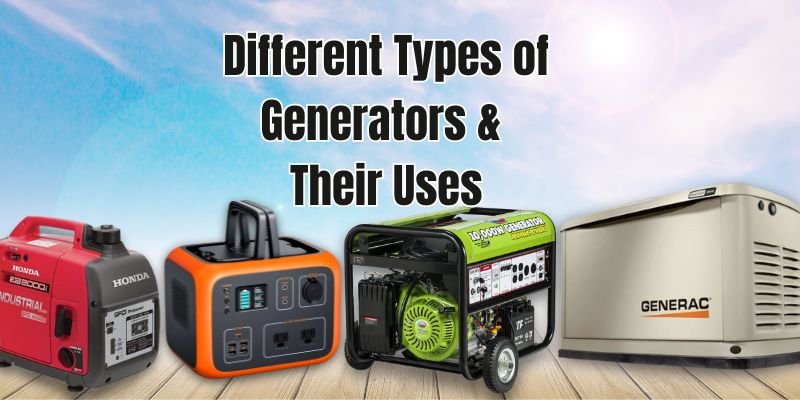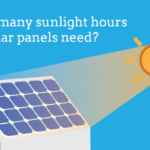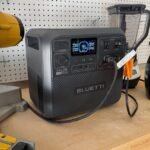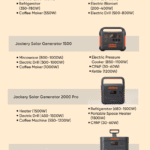Disclosure: This post contains affiliate links and I will be compensated if you make a purchase after clicking through my links. Learn More
Choosing the right breaker size for your generator is crucial. It ensures safety and efficiency.
Generators are handy during power outages. But, using the wrong breaker can cause problems. Breakers protect your generator and your home’s electrical system. Understanding breaker sizes helps avoid overloads and potential hazards. This guide will explain what size breaker you need for your generator.
It will provide easy tips and clear advice. With the right knowledge, you can make an informed decision. Let’s dive into the essentials of choosing the correct breaker size for your generator.
Choosing The Right Breaker
Choosing the right breaker for your generator is crucial. It ensures safety and efficiency. This decision involves understanding the electrical load and the generator’s capacity. The right breaker protects your generator and connected devices. Let’s delve into the importance and common mistakes.
Importance Of Correct Sizing
Correct sizing prevents electrical overloads. An overload can damage your generator and appliances. It can even cause fires. The breaker must match the generator’s output. It should also align with the electrical load you plan to use. Proper sizing ensures smooth operation. It extends the life of your generator.
Common Mistakes
One common mistake is choosing a breaker that’s too large. A large breaker won’t trip during an overload. This can lead to serious damage. Another mistake is selecting a breaker that’s too small. A small breaker trips too often. It interrupts the power supply and can be frustrating. Another error is ignoring the generator’s manual. The manual provides specific recommendations. Always follow them.

Credit: www.amazon.com
Types Of Breakers
When choosing a breaker for your generator, it’s crucial to understand the types available. Different breakers serve different purposes, and selecting the right one can ensure safety and efficiency. Let’s break down the types of breakers to make your decision easier.
Standard Breakers
Standard breakers are the most common type used in residential settings. These breakers protect your electrical circuit from overloads and short circuits. They’re straightforward and reliable.
I remember installing a generator at my friend’s cabin. We opted for a standard breaker because it was simple and effective. It handled the load perfectly during a power outage.
Standard breakers come in various sizes. You need to match the breaker’s size to your generator’s output to ensure optimal performance. Check your generator’s specifications and choose accordingly.
Gfci Breakers
Ground Fault Circuit Interrupter (GFCI) breakers are essential for safety. They protect against electrical shocks by detecting ground faults. If there’s a difference in the current between the hot and neutral wires, the GFCI breaker trips.
Imagine using a generator in a damp environment. A GFCI breaker can prevent potential shocks, making it a safer choice. This type of breaker is often used in kitchens, bathrooms, and outdoor settings.
GFCI breakers are slightly more expensive but worth the investment for added protection. Make sure to consider your environment and the risks involved when choosing your breaker.
Choosing the right breaker not only ensures safety but also maximizes your generator’s performance. Have you ever faced challenges while choosing a breaker for your generator? Share your experiences and questions below!
Calculating Breaker Size
Calculating the right breaker size for your generator is crucial. It ensures safety and efficiency. The breaker size must match your generator’s power requirements and voltage. Let’s break it down into simple steps.
Power Requirements
First, determine the power requirements of your generator. Check the generator’s wattage rating. This is usually found on the generator’s label. It tells you how much power the generator can produce.
Next, calculate the total wattage of the devices you will connect. Add up the wattage of all devices. Ensure the total wattage does not exceed the generator’s capacity. This helps avoid overloading.
Voltage Considerations
Generators come in different voltage ratings. Common voltages are 120V and 240V. The voltage rating affects the breaker size. Check the generator’s voltage rating first.
Use the formula: Breaker Size (in amps) = Total Wattage / Voltage. For example, if the total wattage is 3600W and the voltage is 120V, the breaker size is 30 amps. This formula helps you find the right breaker size.
Always choose a breaker that matches or exceeds the required amperage. This ensures safe operation. Never use a breaker with a lower rating than needed.
Safety Precautions
When deciding on the right breaker size for your generator, safety must be your top priority. Breakers prevent electrical overloads and potential fires. Understanding the risks and proper installation is crucial for safe operation.
Overloading Risks
Overloading your generator can cause serious damage. It can overheat and fail. The right breaker size helps prevent this. If a generator is overloaded, the breaker will trip. This stops the flow of electricity. It protects the generator and connected devices. Always check the wattage of your generator. Match it with the breaker size. This simple step can avoid many problems.
Proper Installation
Proper installation of your breaker is vital. Incorrect wiring can be dangerous. Always follow the manufacturer’s instructions. Use the correct tools. Double-check your connections. If unsure, consult a professional. A licensed electrician can ensure everything is set up correctly. This ensures your safety and prolongs the life of your generator.
Compatibility With Generators
Choosing the right size breaker for your generator is crucial for ensuring safety and optimal performance. Understanding the compatibility between your breaker and generator can be daunting. But don’t worry, we’ve got you covered with some key insights to make this process easier.
Matching Brands
One of the first things to consider is matching brands. Generators and breakers from the same brand are typically designed to work seamlessly together. This can simplify installation and reduce the risk of compatibility issues.
For example, if you have a Generac generator, using a Generac breaker is usually the best option. This not only ensures optimal performance but also helps in maintaining your warranty. Mixing brands can sometimes lead to technical glitches, which you want to avoid.
Technical Specifications
Beyond brand compatibility, understanding the technical specifications is essential. The breaker size should match the generator’s output capacity. For instance, a 5000-watt generator typically requires a breaker rated for 20-25 amps.
Ensure you check the voltage rating as well. Most residential generators operate at 120/240V, so your breaker should be rated for the same voltage. Always refer to the generator’s manual for specific recommendations.
Have you ever faced issues with mismatched breakers and generators? What steps did you take to resolve them? Share your experiences in the comments below.

Credit: www.amazon.com
Installation Tips
When you’re setting up a generator, one of the most crucial aspects is ensuring you have the right size breaker. This ensures the safety of your electrical system and the smooth operation of your generator. Below, we’ll dive into some practical installation tips to help you get this right.
Step-by-step Guide
First, turn off the main power supply to avoid any accidents. Safety should always be your top priority.
Next, determine the wattage of your generator. This will help you decide the size of the breaker you need. For instance, a 5,000-watt generator typically requires a 20-amp breaker.
Then, install the breaker into the service panel. Ensure it fits snugly and securely. Loose connections can be dangerous and may cause electrical failures.
After installing the breaker, connect the generator to the breaker using appropriate wiring. Double-check the connections to ensure everything is tightly secured.
Finally, test the setup by turning on the generator and checking if the breaker trips. If it does, you might need to reconsider the size of the breaker or check for loose connections.
Tools Needed
Having the right tools makes the installation process smoother and safer. Here’s a quick list:
- Voltage Tester: To ensure the power is off before you start working.
- Screwdrivers: Various sizes to fit different screws in the service panel.
- Wire Strippers: For stripping the insulation off the wires.
- Wrench: To tighten any bolts or nuts.
- Breaker: The correctly sized one for your generator.
Using these tools efficiently can make the installation process much easier. Have you ever tried installing a breaker without the proper tools? It can be a real hassle.
Make sure you follow these tips for a smooth and safe installation. Have you had any experiences where the breaker size was incorrect? What did you do to fix it?
Troubleshooting
Choosing the right size breaker for your generator ensures safety and efficiency. Select a breaker that matches your generator’s wattage to avoid electrical issues. Proper sizing helps protect your appliances and wiring from damage.
Whether you’re an experienced DIY enthusiast or a first-time generator owner, troubleshooting issues with your breaker can feel daunting. Understanding common problems and knowing when to call a professional can save you time and frustration.
Common Issues
One common issue is a tripped breaker. This can happen if your generator is overloaded. Check if you’re running too many appliances simultaneously.
Another problem might be loose connections. Over time, vibrations from the generator can loosen connections. Tighten them carefully to ensure a secure fit.
Sometimes, the breaker itself may be faulty. If your breaker frequently trips without an obvious cause, it might need replacing.
When To Call A Professional
If you’ve checked for common issues and your breaker still isn’t working properly, it’s time to call a professional.
Electrical issues can be complex and dangerous. Don’t attempt repairs that are beyond your knowledge.
A professional can diagnose the problem accurately and fix it safely. They have the tools and expertise to handle more serious issues.
Have you ever faced these problems? What steps did you take to resolve them? Share your experiences and let’s troubleshoot together!
Maintenance
Maintaining your generator’s breaker is essential for optimal performance. Regular maintenance ensures safety and longevity. It prevents unexpected failures and costly repairs. Here, we’ll discuss key aspects of breaker maintenance.
Regular Checks
Inspect your generator breaker routinely. Look for signs of wear, corrosion, or damage. Ensure all connections are tight. Loose connections can cause overheating. Listen for unusual noises during operation. Strange sounds may indicate issues.
Check the breaker’s trip settings. Adjust if necessary. Proper settings protect your generator and connected devices. Use a multimeter to test voltage and current. This helps identify potential problems early. Record your findings. It’s useful for future reference.
Replacing Faulty Breakers
Replace faulty breakers immediately. Delays can cause more damage. First, turn off the generator. Safety first. Remove the old breaker carefully. Follow the manufacturer’s instructions.
Install the new breaker. Ensure it matches the generator’s specifications. Check connections and secure them. Test the generator to verify the new breaker works. Monitor it during the first few uses. This ensures everything runs smoothly.
Frequently Asked Questions
How To Size A Breaker For A Generator?
To size a breaker for a generator, match the generator’s output in watts with the breaker’s amperage. Divide the wattage by voltage to get the amperage. Ensure the breaker handles the generator’s maximum load. Always consult the manufacturer’s guidelines for specific requirements.
What Size Breaker For A 7500 Watt Generator?
For a 7500 watt generator, use a 30-amp breaker. Ensure the wiring supports the generator’s load and meets electrical codes.
Can I Run A 30 Amp Generator On A 50 Amp Breaker?
No, you should not run a 30 amp generator on a 50 amp breaker. It poses safety risks and can damage equipment.
What Size Breaker For A 9500 Watt Generator?
Use a 40-amp breaker for a 9500-watt generator. This ensures safe and efficient operation.
Final Words
Choosing the right breaker for your generator is essential for safety. Always check your generator’s manual. Ensure the breaker matches the generator’s output. This prevents overloads and potential damage. Consult an electrician if unsure. Proper setup extends your generator’s life.
It also ensures safe operation. Remember, safety first. Make informed decisions. Protect your investment and peace of mind.








